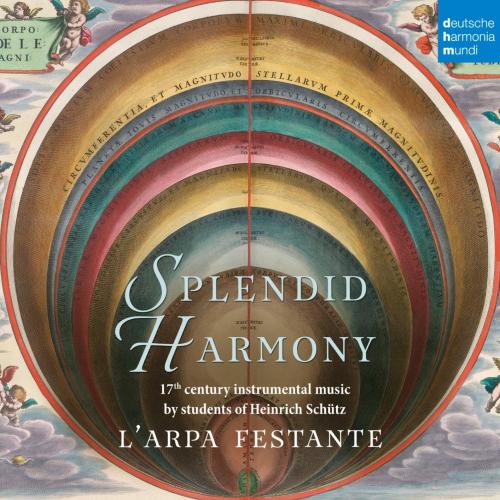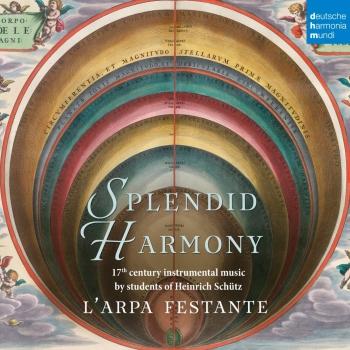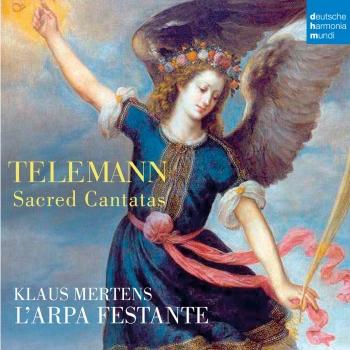
Splendid Harmony - 17th Century Instrumental Music by Students of Heinrich Schütz L'Arpa Festante
Album info
Album-Release:
2017
HRA-Release:
23.06.2017
Label: deutsche harmonia mundi
Genre: Classical
Subgenre: Chamber Music
Artist: L'Arpa Festante
Composer: Clemens Thieme (1631-1688), Johann Wilhelm Furchheim (1635-1682), Johann Vierdanck (1605-1646), Johann Jakob Löwe (1629-1703), David Pohle (1624-1695)
Album including Album cover Booklet (PDF)
I`m sorry!
Dear HIGHRESAUDIO Visitor,
due to territorial constraints and also different releases dates in each country you currently can`t purchase this album. We are updating our release dates twice a week. So, please feel free to check from time-to-time, if the album is available for your country.
We suggest, that you bookmark the album and use our Short List function.
Thank you for your understanding and patience.
Yours sincerely, HIGHRESAUDIO
- Clemens Thieme (1631-1688): Suite à 5 in B Major:
- 1 Suite à 5 in B Major: I. Adagio 04:04
- 2 Suite à 5 in B Major: II. Praeludium 00:36
- 3 Suite à 5 in B Major: III. Allemande 01:31
- 4 Suite à 5 in B Major: IV. Courante 01:24
- 5 Suite à 5 in B Major: V. Sarabande 02:07
- 6 Suite à 5 in B Major: VI. Gigue 00:57
- Clemens Thieme:
- 7 Sonata à 5 in D Minor 04:06
- 8 Sonata à 5 in E Minor 03:52
- Johann Wilhelm Furchheim (ca. 1635-1682): Sonate à 3 in E Minor:
- 9 Sonate à 3 in E Minor: I. Adagio 02:52
- 10 Sonate à 3 in E Minor: II. Allemande 03:03
- 11 Sonate à 3 in E Minor: III. Courante 01:23
- 12 Sonate à 3 in E Minor: IV. Allegro 00:59
- 13 Sonate à 3 in E Minor: V. Sarabande 01:17
- 14 Sonate à 3 in E Minor: VI. Allegro 01:35
- 15 Sonate à 3 in E Minor: VII. Gigue 02:16
- Suite à 5 in B Minor:
- 16 Suite à 5 in B Minor: I. Praeludium. Alla breve 01:37
- 17 Suite à 5 in B Minor: II. Allemande 01:26
- 18 Suite à 5 in B Minor: III. Courante 01:03
- 19 Suite à 5 in B Minor: IV. Sarabande 01:04
- 20 Suite à 5 in B Minor: V. Gigue 01:52
- Johann Vierdanck (ca. 1605-1646): Suite No. 2 à 3 in D Minor:
- 21 Suite No. 2 à 3 in D Minor: I. Pavan 05:04
- 22 Suite No. 2 à 3 in D Minor: II. Gagliarda 01:45
- 23 Suite No. 2 à 3 in D Minor: III. Ballo. Presto 01:36
- 24 Suite No. 2 à 3 in D Minor: IV. Correnta 01:00
- Johann Vierdanck:
- 25 Sonata à 2 Violini Solo in D Minor 04:20
- Johann Jacob Löwe (1629-1703):
- 26 Suite No. 3 à 5 in G Minor: I. Synfonia 02:00
- 27 Suite No. 3 à 5 in G Minor: II. Allemanda 01:18
- 28 Suite No. 3 à 5 in G Minor: III. Gagliarda 00:47
- 29 Suite No. 3 à 5 in G Minor: IV. Couranta 01:07
- 30 Suite No. 3 à 5 in G Minor: V. Sarabanda 01:01
- Johann Jacob Löwe:
- 31 Canzona No. 5 à 2 03:06
- David Pohle (1624-1695):
- 32 Le Testament: I. Serenade 04:46
- 33 Le Testament: II. Courante simple 00:55
- 34 Le Testament: III. Courante 00:49
- 35 Le Testament: IV. Sarabande 01:00
- 36 Le Testament: V. Sarabande 01:28
- 37 Le Testament: VI. La Bourée 01:04
- David Pohle:
- 38 Sonata à 5 in C Major: Allegro - Adagio - Allegro - Adagio 04:56
Info for Splendid Harmony - 17th Century Instrumental Music by Students of Heinrich Schütz
Today Heinrich Schütz (1585–1672) is considered the most important and influential German composer of the early baroque era. In his 55 years of service as chapel master to the court of Saxony in Dresden, he taught not only the choirboys in his chapel but music students sent to him from other German courts. His pupils were highly sought after as (court) chapel masters, orchestra leaders or church music directors throughout northern Europe. L’Arpa Festante (Italian for “The Festive Harp”) is a chamber orchestra with a rich tradition. Founded in Munich in 1983, it has specialised with notable success in the revival of unknown music. This recording, made in the church of Niedereggenen, illustrates the great wealth of music composed by Schütz’s pupils. Under the leadership of Christoph Hesse, the ensemble has recorded suites and sonatas by Clemens Thieme (1631–1688), Johann Wilhelm Furchheim (1635–1682), Johann Vierdanck (1605–1646), Johann Jakob Löwe (1629–1703) and David Pohle (1624–1695) – gems of early German baroque music, all appearing here for the first time on an outstanding recording.
L'arpa Festante
L'arpa festante
The baroque orchestra L’arpa festante takes its name from Giovanni Battista Maccioni’s dramatic work performed at the opening of the Munich opera house in 1653. Its name has come to stand for the group’s artistic work and musical commitment. Founded in 1983, L’arpa festante is one of the longest-established German Early music ensembles. It has achieved an enviable reputation not only for its distinctive sound in performances of instrumental works, but as a partner to leading choirs in works from the whole range of Baroque, Classical and Romantic choral-orchestral literature. The group uses original instruments appropriate to the works it performs, enabling it to faithfully recreate the authentic sounds and colors of these works. The individual players’ extensive musical experience, and the virtuosity of their playing combine to produce the ensemble’s unmistakeable sound: colorful, richly nuanced, sensitive, and expressive. The dramatic moment is spiritedly portrayed through the diverse sounds of historical instruments. The group specializes in the rediscovery and performance of unknown works from the 17th century as well as the Classical era. It increasingly performs oratorios and works from the Romantic symphonic repertoire. The size of the orchestra ranges from solo concertino scoring to full orchestral strength of around 50 musicians, according to the musical requirements of the works performed. Numerous CD recordings, enthusiastically received by critics and public alike, have brought L’arpa festante wide public attention. Their discography comprises around 30 recordings on leading labels and ranges from works of the High Baroque (Rupert Ignaz Mayr, David Pohle, Johann Philipp Förtsch, Dieterich Buxtehude) via the Late Baroque period (Johann Sebastian Bach, Georg Philipp Telemann, George Frideric Handel, Jan Dismas Zelenka) to works of the Classic (Carl Philipp Emanuel Bach, Wilhelm Friedemann Bach, Heinrich Graun, Christian Ernst Graf, Giovanni Battista Martini, Josef Haydn, Wolfgang Amadeus Mozart) and Romantic eras (Anton Bruckner, Camille Saint-Saëns, Hector Berlioz, Bernhard Molique).
Booklet for Splendid Harmony - 17th Century Instrumental Music by Students of Heinrich Schütz










